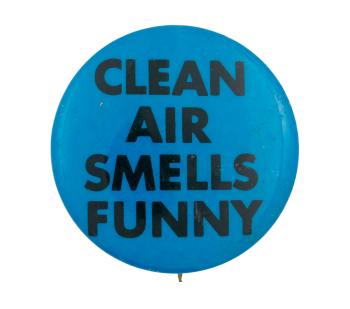| Category | |
|---|---|
| Additional Images | |
| Text on Button | CLEAN AIR SMELLS FUNNY |
| Image Description | Black text on a blue background |
| Back Style | |
| The Shape | |
| The Size | |
| Additional Information | Air pollution, and the health risks associated with it, became a concern for the United States government in the mid 20th Century. In 1963, the U.S. Government enacted the first Clean Air Act followed by the Air Quality Act in 1967. These acts together authorized new monitoring programs and research studies on air pollution in the United States. Regulations and standards based on these findings were then put into practice with the Clean Air Act of 1970. Besides codifying new nationwide standards for air pollutants, this Act created the Environmental Protection Agency and gave it the authority to implement and enforce the new standards. Vehicle emissions were of particular interest at this time, and new regulations governed both the cars and the fuel. Car manufacturers were limited in how much pollution their cars could produce, while fuel refineries were banned from adding certain ingredients, including lead, to commercial gasoline. The Clean Air Act has since been amended twice, in 1977 and in 1990. Compared with 1970, the United States now experiences 66.9% less air pollution and life expectancy has increased by 1.3 years. |
| Sources |
Air Quality Life Index. (2022, August 10). Aqli policy impacts-united states: Clean air act (1970). AQLI. https://aqli.epic.uchicago.edu/policy-impacts/united-states-clean-air-a…. Environmental Protection Agency. (2021). Evolution of the Clean Air Act. EPA. https://www.epa.gov/clean-air-act-overview/evolution-clean-air-act |
| Catalog ID | CA0521 |


